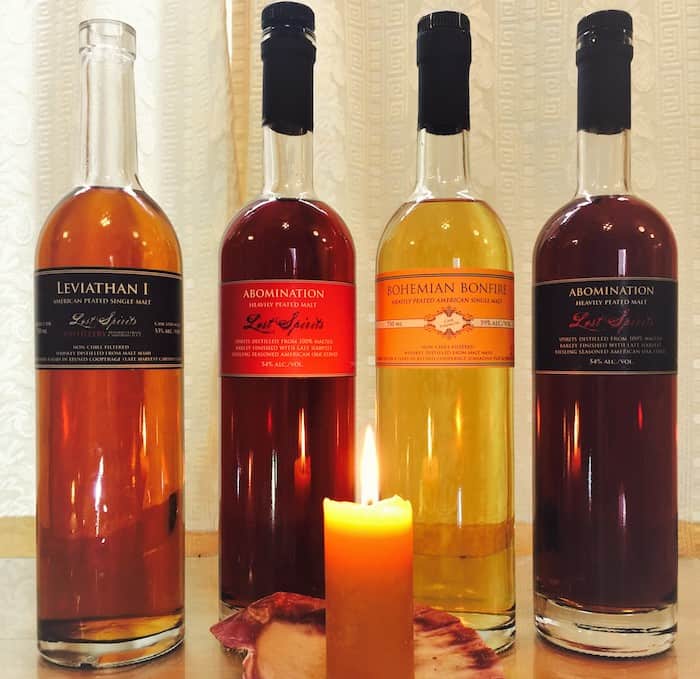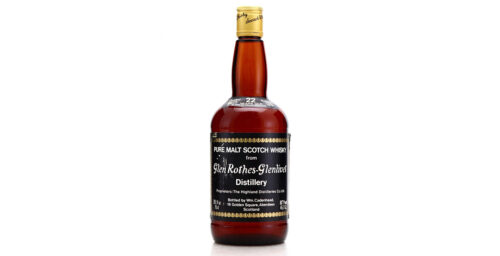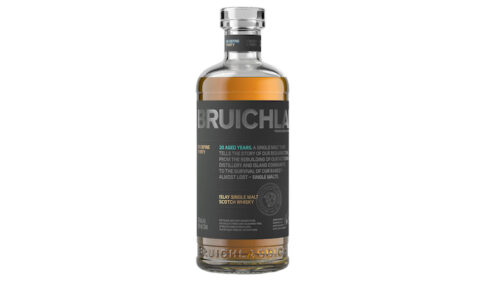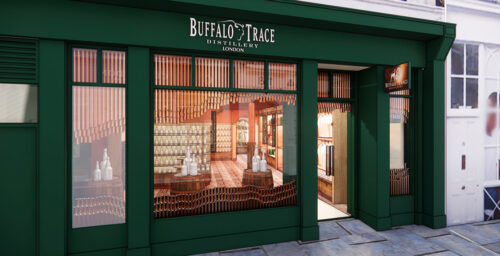Craft distiller Bryan Davis, in whiskey making circles, is known as the co-founder of Lost Spirits, a California-based distillery which has been producing some intriguing whiskey as the years have gone by. In the early days of his whiskey making operation he used mostly Canadian peat and California barley in his production of American single malts, with the PPM levels in some of the resulting whiskies getting up there with Ardbeg’s Supernova and Bruichladdich’s Octomores. It wasn’t long before his traditional barrel aged expressions developed something of a cult following.
But this wasn’t good enough for Davis. He began messing around a few years ago with the scientific side of distillation, and struck upon the idea that photocatalytic light could be used to break down wood polymers in a way that imitated the natural aging process.
It was discovered that a reactor could bind these molecules to unaged alcohol in such a way as to create well-endowed carbon chain esters (yes, length matters). Spirits “aged” with this artificial process have allegedly demonstrated the same chemical signatures as mature spirits aged the old fashioned way: with lots of time spent in casks. In other words, carbon chain esters were successfully lengthened.
Bryan Davis assembled his first prototype reactor in 2015, dubbing his technology with the name THEA (Targeted Hyper-Esterification Aging). Since that time, he’s gone through more generations of that model in an effort to fine tune the thing, with the reactor now said to be able to approximate artificial aging that matches traditional aging up to twenty years of age.
Fast forward to today, and as we recently reported, Davis has set up a new distillery operation in Los Angeles. He has also unleashed to market two variants of his first rapid aged whiskey, called affectionately Abomination, that are individually known as “The Crying of the Puma” and “The Sayers of the Law.”
In this review we will be comparing four of Davis’ whiskeys. Two of the whiskies from Lost Spirits’ older days were aged traditionally (Leviathan I and Bohemian Bonfire), whereas the other two were accelerated in Davis’ reactor with new American oak that was seasoned with late-harvest Riesling staves. How will they play off against one another? Is his rapid aging technology really all that awesome? Let’s find out.

Tasting Notes: Leviathan I
Vital Stats: Leviathan I American peated single malt whiskey; Cask #9; cask strength 53% ABV; 750 ml; non chill filtered; Stored under four years in reused cabernet casks; Average price $62 (no longer available).
Appearance: Burnished copper in color; legs run so fast down the side of the glass that I might venture to call them “tentacles,” with no appreciable beading. How very Lovecraftian. Cthulhu legs anyone? Remember, the younger the whisky, the faster the legs.
Nose: Almost comes across as “new make;” burned molasses; rotten apples; turpentine; diesel fuel; tar and peat.
Palate: Cheap mezcal; oak char; unfocused peat smoke that seems all over the place; burning tires; cotton candy; cocoa powder with artificial sweetener; rotting lemon rinds; saccharine; kerosene; melted plastic.
Finish: The smoke lingers a long while, coating the tongue with sooty carnage. I am left with the flavor of peat and BBQ’d corn on the cob that was left on the grill way too long and has come away black.
Final Thoughts & Score:
The cork on this bottle required a wine cork screw to remove. It was sealed with some sort of plastic that made the removal difficult, even with a high quality cork screw. As a result, the natural wood cork disintegrated into chunks. Luckily, I was able to remove the last third of it as a whole without losing chunks to fall down in the whiskey. However, now I am left with a bottle that has no cork. Luckily, I tend to save corks from empty bottles that I recycle. One of them is bound to fit into the narrow neck of Leviathan.
I sincerely hope Christopher Null at Drinkhacker.com had a radically different tasting experience with Cask #3 that he reviewed. It’s hard to believe he gave this whiskey an “A-” rating. Such a high mark leads me to wonder about cask variation. In all honesty, I doubt there’s all that much difference . . . but who knows.
Tasting Notes: Bohemian Bonfire
Vital Stats: Bohemian Bonfire heavily peated American single malt whiskey; 59% ABV; 750 ml; 160 bottles; stored under four years in reused cooperage (Canadian peat and French oak casks); Average price $62 (no longer available).
Appearance: Pale gold in color; legs run so fast down the sides of the glass that beading is non-existent; I would call these Oprah Winfrey legs.
Nose: Rice vinegar; flat white wine; sweet peat; rotten honey dew melon; candy corn; diesel fuel; smoldering oak logs with singed moss. Time is the best friend of this whisky. With at least ten minutes in the glass, it develops a slightly more harmonious interplay of peat with savory, spice, and oak notes–although the smoke is still fairly all-consuming in a less than desirable way. (It’s worth mentioning that I love some Octomores, so I’m not a “peat prude,” so to speak.)
Palate: Without time in the glass, one gets overpowering peat mixed with diesel; mezcal; candy corn; corn syrup; acorn squash; palm wax. Time mellows out the harshness of the smoke, but leaves the whole thing fairly flat.
Finish: This one is a bit more well balanced than the Leviathan. Now I’m thinking that I should have let the Leviathan rest in my glass before passing judgment on it, and on Christopher Null’s “A-” score. Oh well. Prior to resting in my glass, Bonfire left a finish akin to sucking on a plastic tube that has been roasted over a peat bonfire. Now, it’s more akin to chewing on a wedge of burned squash.
Final Thoughts & Score:
According to my research, Bryan Davis cleaned out his wine barrels very thoroughly for this batch. He also used a smaller heart cut, along with normal oak aging. I think the end result is better than Leviathan I, which seemed all over the place to me.
Be this as it may, I still find Bohemian Bonfire to be a flawed attempt at making a peated whiskey. In fact, I’m scratching my head about how in the heck David Driscoll, the lead buyer at K&L Wine Merchants, could possibly have said at one time that Bohemian Bonfire is, “without a doubt, the best peated American whiskey I’ve ever tasted.”
Really, David. Really. What about McCarthy’s single malt from Oregon? Not every year has been spot-on, but a few of the best years were far better than Bohemian Bonfire. In fact, Drinkhacker gave McCarthy’s an A- rating in 2009. How’s that for ironic?
Tasting Notes: Abomination, The Sayers of the Law
Vital Stats: Abomination, the Sayers of the Law, sourced heavily peated new make spirit further aged in THEA; 54% ABV; 750 ml; NAS; finished with late harvest Riesling seasoned American oak staves (charred). Price range $50-$60.
Appearance: Lovely chestnut olorosso sherry in color; the legs are pretty much non-existent. I’m reminded of the line of demarcation on a beach, which divides water from sand.
Nose: Burning autumn leaves and forest loam brace the nostrils. Oh, I’m liking this much better than the other two already. A smoked rattlesnake note reminds me of Longrow CV just a little bit, and that’s a compliment. Very umami, indeed. Bone broth, roast pork. Hints of rosemary. The peat mingles nicely with savory notes. With time in the glass, sweeter notes emerge, such as hot buttered BBQ corn, beeswax, and honey dew melon.
Wow, those Riesling oak staves are working their magick in my glass. This one has an atypical nose, to be sure. Sharp, young, tangy, and bracing. Yes, it noses as if it’s older than “new make” spirit . . . but not over, perhaps, four years of age (tops). The end result is pleasing none the less. So far, so good.
Palate: Smoky, creamy, yummy. Yes, I think it’s the staves, all right. More smoke and savory notes galore. Pan-fried rattlesnake, delicious smoked peaty notes that remind me of good beef jerky, the kind with molasses baked in. Now I’m getting some dried moss (old man’s beard), roasted chickory (circa New Orleans, French Quarter at noon), and some creaminess that evokes a tart impression of Greek yogurt (full fat content, but plain). On the sweeter side, there’s a hint of corn syrup and carnauba wax.
Finish: This one is shorter than the other two, but it’s enjoyable. I would call it medium in length. Burnt caramel drizzled over mesquite briquettes , along with a faint hint of smoke from BBQ baby back ribs sizzlin’ on the barbie.
Final Thoughts & Score:
The Sayers of the Law is more focused than the other two whiskeys that I’ve tasted so far. In fact, I might go so far as to compare it with a few Westland Distillery releases. However, it’s not in the same class as the Garryanna Wood release in Westland’s Native Oak Series, which left me speechless. The Sayers of the Law makes good use of charred oak. It’s rather “chewy,” and that’s a good thing, which usually only happens in older whiskies that have spent a long time in barrels absorbing wood characteristics.
This said, I think such a curious result in The Sayers of the Law has more to do with the use of staves than much of anything else. I’m actually a proponent of staves, and I’ve defended Compass Box’s use of them in early editions of Spice Tree Blended Malt Scotch.
Tasting Notes: Abomination, The Crying of the Puma
Vital Stats: Abomination, the Crying of the Puma, sourced heavily peated new make spirit further aged in THEA; 54% ABV; 750 ml; NAS; finished with late harvest Riesling seasoned American oak staves (toasted). Price range $50-$60.
Appearance: Deep copper with flickering golden highlights; this one has legs with beading. Aha! They flow quickly down the sides of my glass, but not before some perky beads appear.
Nose: This one is very similar to “Law” but exudes a sweeter scent. There’s star anise, wet coral, decadent caramel, caraway seeds, dark rye bread with raisins, vanilla bean, and a tantalizing peat presence that does not dominate to the exclusion of complexity. Most complex nose of the bunch.
Palate: Smoky and savory notes emerge first, along with a wave of faint sweetness that borders on caramel and cream. Although I don’t taste licorice or anise, there is a nice, strong barley note that reminds me of Scottish steel cut oaks with canned pears. On the palate, this whiskey is not as complex as “Law.” The taste is pleasant but somewhat bland.
Finish: Peaty smoke lasts and lasts. How could it be longer than charred staves? I don’t know, but it is. A nice autumnal finish extends for quite a long while, rivaling the likes of an Uigeadail, a Kilchoman, or an early Octomore in terms of raw power, but not in terms of anything else.
Final Thoughts & Score:
I can certainly taste the difference between Law and Puma when they are compared with Leviathan and Bonfire. As you can see from my three star ratings, the whiskies that Lost Spirits did not distill are much better. As to whether this difference is because of the rapid aging process or because of the fact that the whisky was originally sourced from Scotland as slightly aged new make spirit, I really can’t say.
In the final analysis, “Puma” is just okay. It noses and tastes like a 3-4 year old heavily peated whisky, in my estimation. So I guess the rapid aging process worked, at least to some extent. This said, Puma seems flat and lifeless. I’ve nosed and tasted plenty of Octomores that are the same approximate age, and yet exude far more complexity, depth, and charm.
The Sum of The Parts
In the final analysis, I’m partial to The Sayers of the Law over The Crying of the Puma. It has that rare umami quality that I sometimes crave. Recently, I enjoyed a Springbank 12 Year Old Cask Strength that included such an added bonus on the nose and palate.
Lost Spirits released at one point a bottling called Umami. After trying “Law,” I’m apt to track down an Umami to review in the future. Now, believe it or not, I really do find Lost Spirits to be a promising distillery. Before writing this review, I watched the entire TED Talk that Bryan Davis gave in Bermuda on his technology. It was entertaining, to say the least. In the lecture, he’s refreshingly candid about his own personal history of booze-making.
Using rapid aging technology to make a very young whiskey taste a little less young might appeal to high volume distillers who want to cut corners, and increase their profit margins. However, I’m not completely sold on the idea. In fact, I will go on record as stating that neither of the Abominations tasted older than five years to me.
If new make spirit was “rapid aged” to create the impression of an older spirit, which, in my estimation tastes like it is 3-4 years old, then I guess such a feat is fairly impressive. This said, the end result, especially in Puma, was a bit flat. Also, in all fairness, I have never jumped at the chance to taste a four year old heavily peated whisk(e)y. Even Bruichladdich’s Octomores are at least a year older than that.
I would certainly be interested in tasting an artificially matured new make that is supposed to approximate the profile of a 20 year old single malt whisky. The proof would be in the bottle, so to speak. Smelling and tasting is believing. If Davis were to pull off such a feat of technological prowess, then I’d have no problem admitting it, though.
Over the years, I’ve sampled dozens and dozens of whiskies that were 20+ years of age. So I have more than enough experience, and the “chops,” to tell the difference. This said, I am a Doubting Thomas. Even if a panel of judges at a fancy competition were to unanimously agree that Bryan Davis had accomplished the impossible, I wouldn’t believe them unless I’d had the chance to sample the artificially matured–er, I mean “rapid aged”–whiskey for myself.
Speaking of which, I wonder if the photocatalytic process, when applied in reverse, could make a man younger by shortening his carbon chains? Or perhaps Davis’s mystery malt has the ability to rapid age the flesh of cult followers? Bottoms up.







